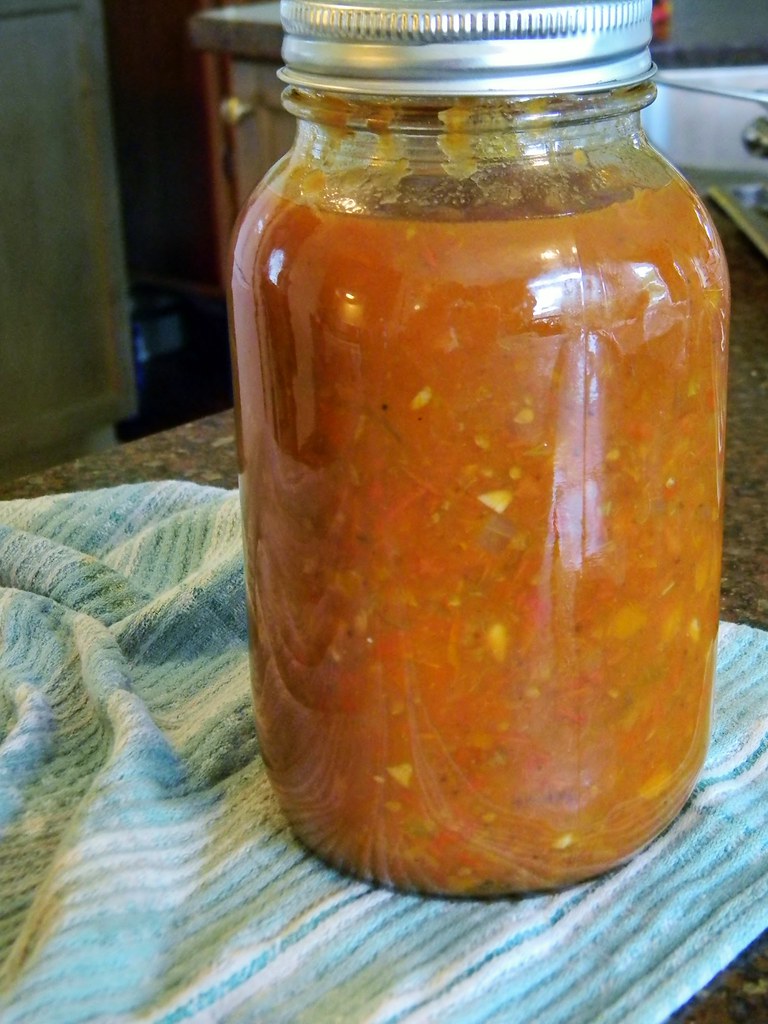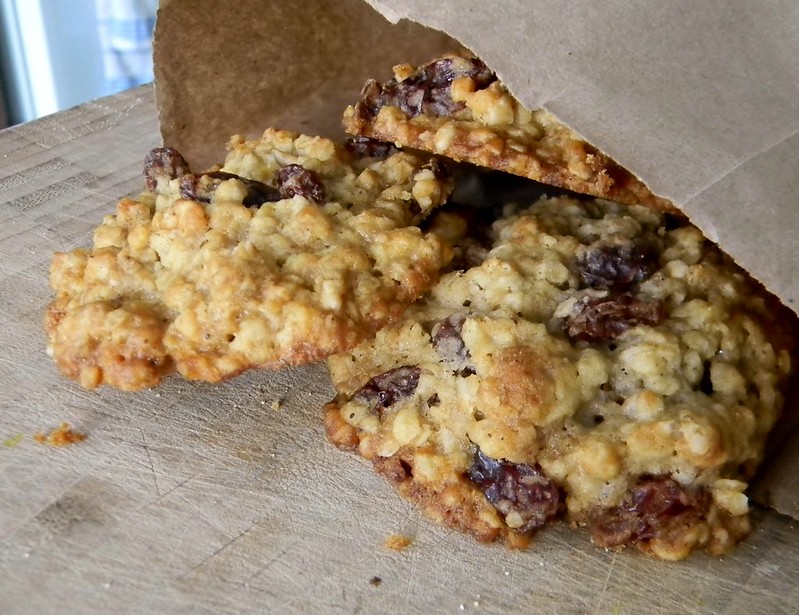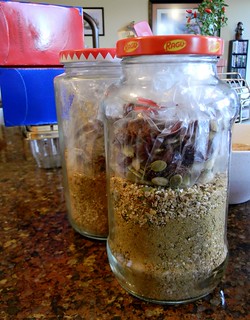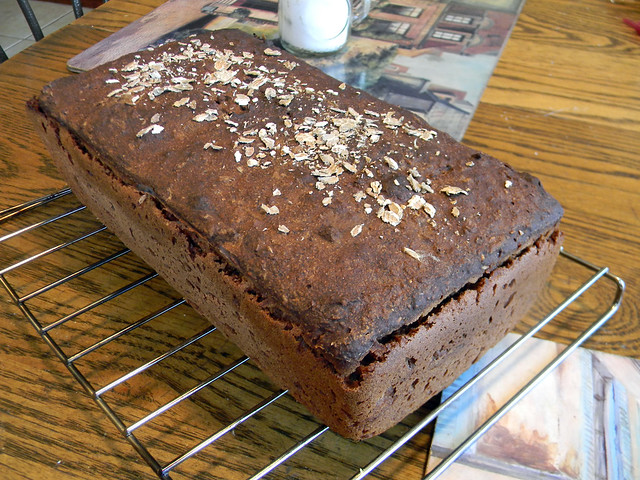I never thought I'd be as much of an oatmeal raisin cookie fan as I am. As a kid, if the cookie didn't contain chocolate (or peanut butter), I didn't even bat an eye - the notable exception being my mom's killer shortbreads. As my palate matured, I became more open to oatmeal cookies in general, provided that they were chewy, toasty and their additions were moist. I've been on the hunt for a killer OR cookie recipe for years, and while each one I've made has merits, none of them will match the Dad's Cookies we would buy fresh from their bakery outlet store years ago. Ironically, the company now only sells crunchy cookies, so buying them is off the table!
At least the dearth of good cookies in our vicinity has opened up the opportunity to experiment, and when I saw Donna Quan's (the Toronto District School Board Director) Oatmeal Cookies in the Toronto Star I knew they could be contenders. Heck, if the kids at school adore the recipe, I could definitely try them too! I took the original chewy, hearty cookies and made them even more school-friendly by using less sugar, cutting the cholesterol, boosting the whole grain content and adding a new layer of flavour with flavourful coconut oil. I also heeded the little bit of knowledge I've learned about making good oatmeal cookies and refrigerated the dough overnight, which let the oats and spelt flour fully hydrate and thus bake evenly. I was skeptical of the long bake time too, but it turned out to be a successful way of baking the drops through (and keeping them from falling apart) while maintaining their moisture.
All I know now is that these aren't 100% perfect, but they sure are close - and even with school ending (and Summer camp starting) soon, kids of all ages are going to need an afternoon snack!
Sunday, June 8, 2014
Friday, June 6, 2014
Moroccan Pasta Sauce
If I could travel anywhere overseas, I'd go to Morocco. There is something about the exotic sights, sounds, aromas and flavours of that country that is unlike anything else in the world. Thanks to the heavy French and Arabic influences, the buildings are gorgeous and the food even more so. You can get a classic French croissant in the middle of the market, just down the street from a lavish tagine restaurant and a merchant selling mountains of spices, dates, figs and nuts. Although meat (especially chicken and lamb) is definitely a staple in the diet, there is a hefty use of legumes and vegetables too. Bread and couscous are essentially mandatory at every meal, which makes this carb-addict happy, and all this gustatory paradise is accompanied by the burble of the market, the music and the calls from the mosques.
 As an homage to all the flavours I love in Moroccan cuisine, last year I used up all the Summer's-end tomatoes and peppers and created this thick, exotic pasta sauce. The marriage of my garden's bounty and pure pomegranate juice was already beyond your standard marinara, but I took the base and really travelled to my favourite country with a medley of garlic, spices and the merest hint of floral saffron. We've used it for all sorts of things - over rice, couscous and pasta, as a bread dipper, and combined with cooked chickpeas, spinach and rice as an impromptu stew. I bet it would make a fabulous dip or topping for grilled meat or fish skewers too.
As an homage to all the flavours I love in Moroccan cuisine, last year I used up all the Summer's-end tomatoes and peppers and created this thick, exotic pasta sauce. The marriage of my garden's bounty and pure pomegranate juice was already beyond your standard marinara, but I took the base and really travelled to my favourite country with a medley of garlic, spices and the merest hint of floral saffron. We've used it for all sorts of things - over rice, couscous and pasta, as a bread dipper, and combined with cooked chickpeas, spinach and rice as an impromptu stew. I bet it would make a fabulous dip or topping for grilled meat or fish skewers too.
Shared with Gluten Free Fridays
 As an homage to all the flavours I love in Moroccan cuisine, last year I used up all the Summer's-end tomatoes and peppers and created this thick, exotic pasta sauce. The marriage of my garden's bounty and pure pomegranate juice was already beyond your standard marinara, but I took the base and really travelled to my favourite country with a medley of garlic, spices and the merest hint of floral saffron. We've used it for all sorts of things - over rice, couscous and pasta, as a bread dipper, and combined with cooked chickpeas, spinach and rice as an impromptu stew. I bet it would make a fabulous dip or topping for grilled meat or fish skewers too.
As an homage to all the flavours I love in Moroccan cuisine, last year I used up all the Summer's-end tomatoes and peppers and created this thick, exotic pasta sauce. The marriage of my garden's bounty and pure pomegranate juice was already beyond your standard marinara, but I took the base and really travelled to my favourite country with a medley of garlic, spices and the merest hint of floral saffron. We've used it for all sorts of things - over rice, couscous and pasta, as a bread dipper, and combined with cooked chickpeas, spinach and rice as an impromptu stew. I bet it would make a fabulous dip or topping for grilled meat or fish skewers too. Shared with Gluten Free Fridays
Wednesday, June 4, 2014
Banana Granola Breakfast Cookies
I'm not the biggest "breakfast" person. It's funny, because when I was growing up my days were all about breakfast - whether it was greedily eating dry Shredded Wheat and calling it "hay" (I ate - and still eat - all cereal sans milk), sitting down to Sunday morning French toast, pancakes or waffles, or even nuking a bowl of leftover spaghetti with butter and cheese before going off to school. These days, the thought of eating before 11AM or so turns my stomach - I just can't deal with a full meal when I wake up!
That said, I totally get the importance of eating breakfast, especially as a teacher. No way am I going to head to the masses of bright-eyed, bushy-tailed and energetic children every day without sustenance. So I made myself a compromise: breakfast cookies. They're a breakfast that I can tuck in my bag and eat while sitting in traffic (or while typing at my desk on the weekends). It's small, portable and buys me a little more time in the morning - plus I pack two of them so that I can enjoy a "second breakfast" at morning break.
My habit seems to be influential on the other staff (and my classmates) too: some of these Banana-Granola cookies wound their way into the bag of a co-worker, the rest went to the staff room and disappeared! They are moist and rich-tasting thanks to a boatload of mashed bananas, with a little crunch from granola and extra interest from dehydrated bananas. Of course, being breakfast, I wanted them to have some semblance of health too, so I opted for a mixture of dark brown sugar, maple syrup, Truvia and Pure Via Turbinado and Stevia Blend for a well rounded but lower-sugar result. Spelt flour amped up the fibre, and a few dashes of spice jazzed things up.
You can opt to bake them all at once (keep them in the freezer though unless you're feeding an army) or do what I tend to do: make the batter, scoop out portions onto a wax or parchment lined baking sheet and freeze. Transfer them to a ziploc bag and keep in the freezer, then pop out one or two as needed and bake them while your coffee is brewing, you're in the shower, you're watching the morning news show... whatever. Just add two minutes to the bake time and you're ready to go. If you're really pressed for time in the morning, bake them the night before and place them on a plate covered with a napkin. No excuse for missing breakfast when it's sitting right in front of you!
That said, I totally get the importance of eating breakfast, especially as a teacher. No way am I going to head to the masses of bright-eyed, bushy-tailed and energetic children every day without sustenance. So I made myself a compromise: breakfast cookies. They're a breakfast that I can tuck in my bag and eat while sitting in traffic (or while typing at my desk on the weekends). It's small, portable and buys me a little more time in the morning - plus I pack two of them so that I can enjoy a "second breakfast" at morning break.
My habit seems to be influential on the other staff (and my classmates) too: some of these Banana-Granola cookies wound their way into the bag of a co-worker, the rest went to the staff room and disappeared! They are moist and rich-tasting thanks to a boatload of mashed bananas, with a little crunch from granola and extra interest from dehydrated bananas. Of course, being breakfast, I wanted them to have some semblance of health too, so I opted for a mixture of dark brown sugar, maple syrup, Truvia and Pure Via Turbinado and Stevia Blend for a well rounded but lower-sugar result. Spelt flour amped up the fibre, and a few dashes of spice jazzed things up.
You can opt to bake them all at once (keep them in the freezer though unless you're feeding an army) or do what I tend to do: make the batter, scoop out portions onto a wax or parchment lined baking sheet and freeze. Transfer them to a ziploc bag and keep in the freezer, then pop out one or two as needed and bake them while your coffee is brewing, you're in the shower, you're watching the morning news show... whatever. Just add two minutes to the bake time and you're ready to go. If you're really pressed for time in the morning, bake them the night before and place them on a plate covered with a napkin. No excuse for missing breakfast when it's sitting right in front of you!
Monday, June 2, 2014
Festive Bulgur Mix
I love my whole grains. Not only are they packed with nutrition, but they have such unique flavour profiles (compared to refined starches) that you can't ignore them on a plate. While there are a good amount of them that take a while to cook thoroughly, I've been able to find a handful of delicious and fast options to keep in the weeknight pantry.
One of those wholegrain staples is bulgur. You've seen it in breads of mine, and may have even eaten it in tabbouleh once or twice - but my favourite way to enjoy the par-cooked cracked wheat is in pilafs or as a base for stir fries. Fluffy and couscous-size, it's a base that can stand up well to intense flavours, especially those from Middle Eastern and African cooking. It's lickety-split to cook too, so it makes a great last minute side. To streamline the whole pilaf process even more, I sometimes mix up a few batches of the dry ingredients on the weekend. That way, the whole process doesn't take any longer than a pre-packaged side dish would and you know you haven't forgotten anything! For this particular mix, I jazzed up the grain with Middle Eastern / Mediterranean herbs and spices, dried fruit, almonds and pumpkin seeds.
Not only is it delicious warm (it makes a fabulous vegan meal with a can of chickpeas stirred in), it's more than passable as a room temperature salad (hello potluck staple!). My family has eaten it both ways, and the consensus from the omnivore is that it's best warm as an accompaniment to grilled meat like lamb, beef or chicken skewers. I call it good in any form!
One of those wholegrain staples is bulgur. You've seen it in breads of mine, and may have even eaten it in tabbouleh once or twice - but my favourite way to enjoy the par-cooked cracked wheat is in pilafs or as a base for stir fries. Fluffy and couscous-size, it's a base that can stand up well to intense flavours, especially those from Middle Eastern and African cooking. It's lickety-split to cook too, so it makes a great last minute side. To streamline the whole pilaf process even more, I sometimes mix up a few batches of the dry ingredients on the weekend. That way, the whole process doesn't take any longer than a pre-packaged side dish would and you know you haven't forgotten anything! For this particular mix, I jazzed up the grain with Middle Eastern / Mediterranean herbs and spices, dried fruit, almonds and pumpkin seeds.
Sunday, June 1, 2014
100% Rye Sourdough
I come by my love of bread honestly. Not only does my mom crave slices of a good, hearty loaf (none of that Wonder stuff), but she's a fabulous breadmaker in her own right. She in turn learned at the hip of my grandfather, when the two of them would churn out 4+ loaves a week in order to feed the 5 person family. While the recipe wasn't extravagant (and certainly not expensive), it was good and filling, making fabulous packed lunch sandwiches for many years.
I can only guess where my grandfather honed his art, but family lore suggests it might have to do with an influx of old-world Jewish culture mixed with our family's Scottish heritage. Nobody knows for sure if there is actually Hebrew in our ancestry, but my grandfather, uncle and male cousins on that side of the family all have what we call the "Jewish nose" and even I (the pasty-white redhead) have been asked if I had Jewish roots. Whatever the reason, I always associate the best loaves (homemade or otherwise) with his chewy, robust whole wheats and ryes.
It is the dark, rich rye sourdough that wins my mom's favour when presented with an array at the bakery. I have played with rye flour in the past, but never exclusively used it in a yeast bread since it's low in gluten and makes for dense, dry outcomes. That said, my sourdough starter is fed almost 100% with rye flour, and I knew artisan bakers make pure rye loaves, so why not me? I found a promising recipe on Shipton Mill's website to start from, and added colour with cocoa powder and molasses, tenderness with pineapple juice, flavour with caraway seeds and texture (not to mention extra rye-ness) with rye flakes. Like all sourdoughs, the dough takes a good, long time to rise: 6 hours after the first mix, followed by 8 hours in the fridge and another 3 at room temperature before baking. Once cooled, the loaf is moist, dense but not heavy and definitely a perfect loaf to slice thin and put on a cheese or charcuterie plate. If cheese and cold cuts aren't your thing, thick slabs of this, toasted and smeared with jam, make a fantastic breakfast too!
Like I try to with most of my breads (and especially sourdoughs), I use weight as my measurement. It solves the issue of settled flour and helps when you're modifying the baker's percentages, basically ensuring consistency in the final dough.
I can only guess where my grandfather honed his art, but family lore suggests it might have to do with an influx of old-world Jewish culture mixed with our family's Scottish heritage. Nobody knows for sure if there is actually Hebrew in our ancestry, but my grandfather, uncle and male cousins on that side of the family all have what we call the "Jewish nose" and even I (the pasty-white redhead) have been asked if I had Jewish roots. Whatever the reason, I always associate the best loaves (homemade or otherwise) with his chewy, robust whole wheats and ryes.
It is the dark, rich rye sourdough that wins my mom's favour when presented with an array at the bakery. I have played with rye flour in the past, but never exclusively used it in a yeast bread since it's low in gluten and makes for dense, dry outcomes. That said, my sourdough starter is fed almost 100% with rye flour, and I knew artisan bakers make pure rye loaves, so why not me? I found a promising recipe on Shipton Mill's website to start from, and added colour with cocoa powder and molasses, tenderness with pineapple juice, flavour with caraway seeds and texture (not to mention extra rye-ness) with rye flakes. Like all sourdoughs, the dough takes a good, long time to rise: 6 hours after the first mix, followed by 8 hours in the fridge and another 3 at room temperature before baking. Once cooled, the loaf is moist, dense but not heavy and definitely a perfect loaf to slice thin and put on a cheese or charcuterie plate. If cheese and cold cuts aren't your thing, thick slabs of this, toasted and smeared with jam, make a fantastic breakfast too!
Like I try to with most of my breads (and especially sourdoughs), I use weight as my measurement. It solves the issue of settled flour and helps when you're modifying the baker's percentages, basically ensuring consistency in the final dough.
Shared with YeastSpotting
Subscribe to:
Posts
(
Atom
)



